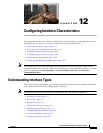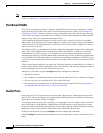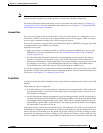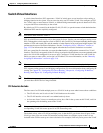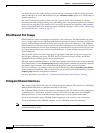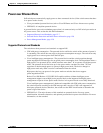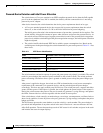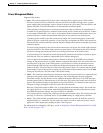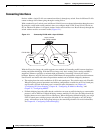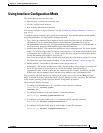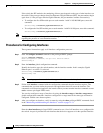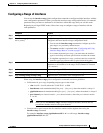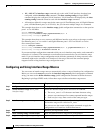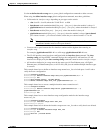
12-8
Catalyst 3750 Switch Software Configuration Guide
OL-8550-09
Chapter 12 Configuring Interface Characteristics
Understanding Interface Types
Powered-Device Detection and Initial Power Allocation
The switch detects a Cisco pre-standard or an IEEE-compliant powered device when the PoE-capable
port is in the no-shutdown state, PoE is enabled (the default), and the connected device is not being
powered by an AC adaptor.
After device detection, the switch determines the device power requirements based on its type:
• A Cisco pre-standard powered device does not provide its power requirement when the switch
detects it, so the switch allocates 15.4 W as the initial allocation for power budgeting.
The initial power allocation is the maximum amount of power that a powered device requires. The
switch initially allocates this amount of power when it detects and powers the powered device. As
the switch receives CDP messages from the powered device and as the powered device negotiates
power levels with the switch through CDP power-negotiation messages, the initial power allocation
might be adjusted.
• The switch classifies the detected IEEE device within a power consumption class. Based on the
available power in the power budget, the switch determines if a port can be powered. Table 12-1 lists
these levels.
The switch monitors and tracks requests for power and grants power only when it is available. The switch
tracks its power budget (the amount of power available on the switch for PoE). The switch performs
power-accounting calculations when a port is granted or denied power to keep the power budget up to
date.
After power is applied to the port, the switch uses CDP to determine the actual power consumption
requirement of the connected Cisco powered devices, and the switch adjusts the power budget
accordingly. This does not apply to third-party PoE devices. The switch processes a request and either
grants or denies power. If the request is granted, the switch updates the power budget. If the request is
denied, the switch ensures that power to the port is turned off, generates a syslog message, and updates
the LEDs. Powered devices can also negotiate with the switch for more power.
If the switch detects a fault caused by an undervoltage, overvoltage, overtemperature, oscillator-fault, or
short-circuit condition, it turns off power to the port, generates a syslog message, and updates the power
budget and LEDs.
The PoE feature operates the same whether or not the switch is a stack member. The power budget is
per-switch and independent of any other switch in the stack. Election of a new stack master does not
affect PoE operation. The stack master keeps track of PoE status for all switches and ports in the stack
and includes the status in output displays.
Table 12-1 IEEE Power Classifications
Class Maximum Power Level Required from the Switch
0 (class status unknown) 15.4 W
14 W
27 W
3 15.4 W
4 (reserved for future use) Treat as Class 0




